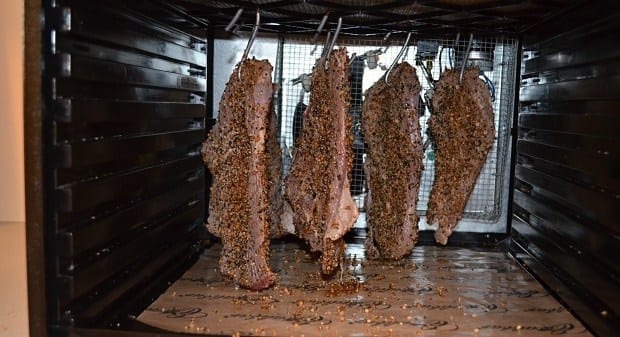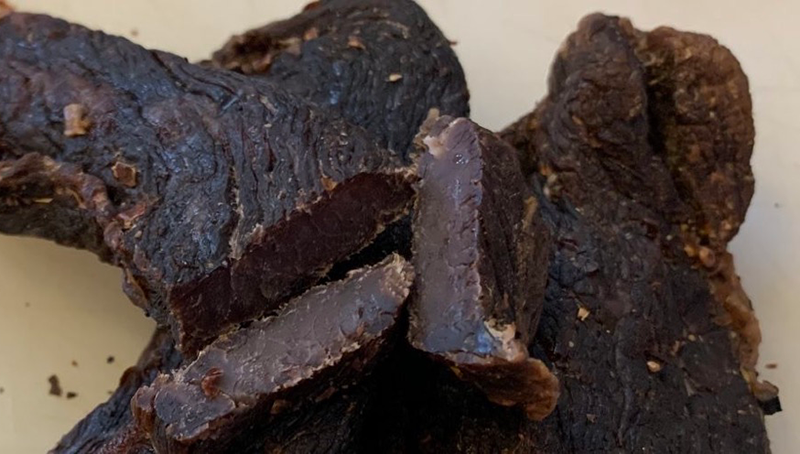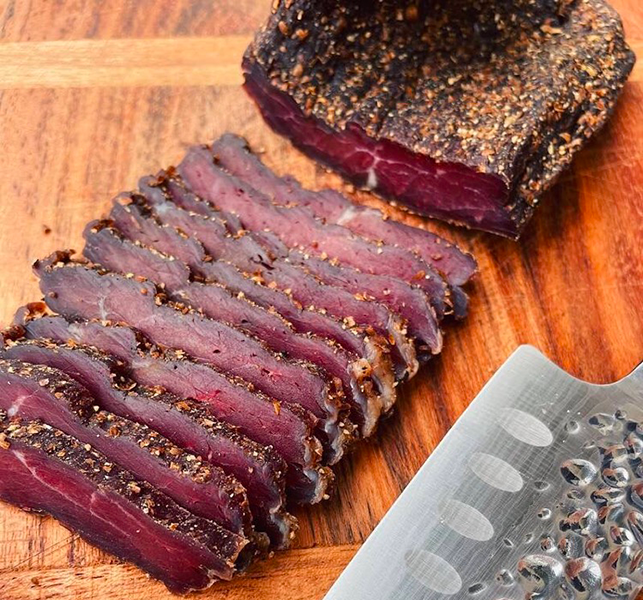
Content Menu
● Understanding Biltong
● The Benefits of Using a Food Dehydrator
● Preparing Your Ingredients
● Dehydrating Biltong
● Tips for Perfect Biltong
● The Science Behind Drying Meat
● Common Mistakes to Avoid
● Biltong vs Jerky
● Conclusion
● FAQ
>> 1. What type of meat is best for making biltong?
>> 2. How long does it take to make biltong in a dehydrator?
>> 3. Can I use other meats besides beef?
>> 4. Is it necessary to use vinegar in the marinade?
>> 5. How should I store my biltong once it's dried?
● Citations:
Biltong, a traditional South African dried meat snack, has gained popularity worldwide for its rich flavor and nutritional benefits. While the classic method of making biltong involves air drying in a well-ventilated space, many enthusiasts wonder if a food dehydrator can achieve similar results. This article explores the process of making biltong in a food dehydrator, providing detailed instructions, tips, and insights into the equipment needed.

Understanding Biltong
Biltong is made from various cuts of meat, typically beef, that are cured with salt, vinegar, and spices before being dried. The drying process not only preserves the meat but also enhances its flavor. The primary ingredients for making biltong include:
- Meat: Common choices are beef round, silverside, or topside.
- Non-Iodized Salt: Essential for curing and preserving.
- Spices: Typically includes black pepper and coriander.
- Vinegar: Used for marinating and adds acidity to prevent bacterial growth.
The Benefits of Using a Food Dehydrator
Using a food dehydrator to make biltong offers several advantages:
- Controlled Environment: Dehydrators maintain consistent temperatures and airflow, which is crucial for even drying.
- Faster Drying Time: Compared to traditional methods, dehydrators can significantly reduce the time required to dry the meat.
- Less Risk of Contamination: The enclosed environment minimizes exposure to pests and contaminants.
Preparing Your Ingredients
Before starting the dehydration process, it's essential to prepare your ingredients properly. Here's how:
1. Select Your Meat: Choose high-quality cuts of meat. Trim any excess fat to enhance shelf life.
2. Cut the Meat: Slice the meat along the grain into strips about 1 inch thick. Thinner strips will dry faster but may become too tough if over-dried.
3. Marinate: In a bowl, combine vinegar with your choice of spices (typically coriander seeds and black pepper) and rub this mixture into the meat. Allow it to marinate for at least 6 hours or overnight for deeper flavor absorption.
4. Drying Mixture: Prepare a spice mix with salt, ground coriander, and black pepper. Coat the marinated meat thoroughly with this mixture.
Dehydrating Biltong
Once your ingredients are ready, follow these steps to dehydrate your biltong:
1. Set Up Your Dehydrator: Preheat your food dehydrator to a low temperature setting (around 35°C to 70°C or 95°F to 158°F). Lower temperatures allow for slower drying, which is ideal for biltong.
2. Arrange the Meat: Place the coated meat strips on the dehydrator trays. Ensure that they are spaced apart adequately to allow airflow around each piece.
3. Start Dehydrating: Run the dehydrator for approximately 12-24 hours depending on the thickness of your strips and desired dryness level. Flip the meat halfway through to ensure even drying.
4. Check for Doneness: The biltong should be firm on the outside but still slightly pliable on the inside when done. If you prefer it drier, extend the drying time accordingly.
5. Cooling and Storing: Once dried, let the biltong cool completely before storing it in an airtight container. This helps prevent moisture buildup which can lead to spoilage.

Tips for Perfect Biltong
To enhance your biltong-making experience using a dehydrator:
- Experiment with different spices or marinades to create unique flavors.
- Consider using a hanging method if your dehydrator allows it; this can improve airflow around each piece of meat.
- Monitor humidity levels in your environment; high humidity may require longer drying times.
The Science Behind Drying Meat
Understanding how dehydration works can help you achieve better results when making biltong. Dehydration removes moisture from food through heat and airflow, which inhibits bacterial growth and spoilage. Here are some key points about this process:
- Moisture Content: Fresh meat contains about 70% water. Removing this moisture is essential for preservation.
- Temperature Control: Keeping temperatures low (between 30°C - 40°C or 86°F - 104°F) prevents cooking while allowing moisture evaporation.
- Airflow Importance: Proper airflow helps remove moisture quickly and evenly from all sides of the meat.
Common Mistakes to Avoid
When making biltong in a dehydrator, be aware of common pitfalls that can affect quality:
- Overcrowding Trays: Placing too much meat on one tray can restrict airflow, resulting in uneven drying.
- Incorrect Temperature Settings: Using too high a temperature can cook the meat instead of drying it properly.
- Insufficient Marination Time: Not allowing enough time for marination can lead to bland flavors in your final product.
Biltong vs Jerky
While both biltong and jerky are dried meats, there are significant differences between them:
| Feature | Biltong | Jerky |
| Preparation Method | Cured with salt & vinegar | Cooked slowly at high temperatures |
| Texture | Chewy with a slight tenderness | Firm and often tougher |
| Flavor Profile | Richer due to spices & vinegar | Often sweeter due to marinades |
| Drying Method | Air-dried or dehydrated | Usually dehydrated after cooking |
Conclusion
Making biltong in a food dehydrator is not only possible but can yield delicious results that rival traditional methods. The key lies in controlling temperature and airflow while ensuring proper marination and seasoning of the meat. With practice, you can perfect your biltong recipe tailored to your taste preferences.

FAQ
1. What type of meat is best for making biltong?
The best meats for biltong are lean cuts such as beef round, silverside, or topside due to their low-fat content which helps in preserving longer.
2. How long does it take to make biltong in a dehydrator?
Typically, it takes between 12 to 24 hours depending on the thickness of your meat strips and desired dryness level.
3. Can I use other meats besides beef?
Yes! While beef is traditional, you can also use game meats like venison or even turkey and chicken for variations of biltong.
4. Is it necessary to use vinegar in the marinade?
Yes, vinegar not only adds flavor but also helps prevent bacterial growth during the curing process.
5. How should I store my biltong once it's dried?
Store dried biltong in an airtight container at room temperature away from direct sunlight to maintain its quality and prevent spoilage.
Citations:
[1] https://selfsufficientme.com/how-to-make-biltong-using-an-excalibur-dehydrator/
[2] https://embersnacks.com/blogs/news/how-to-make-biltong
[3] https://www.luvele.com.au/blogs/recipe-blog/how-to-make-the-best-homemade-biltong
[4] https://yumbiltongfamily.com/making-biltong-in-a-dehydrator/
[5] https://twoguysandacooler.com/biltong/
[6] https://www.youtube.com/watch?v=8ASX2EIQWl4
[7] https://www.weschenfelder.co.uk/blog/making-biltong-with-a-dehydrator
[8] https://cdn.prod.website-files.com/61b94df587eced2bbd705326/6281e004a950842474ae4936_IMG_6684.jpg?sa=X&ved=2ahUKEwjciPeOidaKAxUoBDQIHaRqO1QQ_B16BAgEEAI
[9] https://cdn.prod.website-files.com/61b94df587eced2bbd705326/6281e004a950842474ae4936_IMG_6684.jpg?sa=X&ved=2ahUKEwjO4vaOidaKAxX9LUQIHUPFDOQQ_B16BAgCEAI
[10] https://hackoutdoors.com/biltong-in-a-dehydrator











